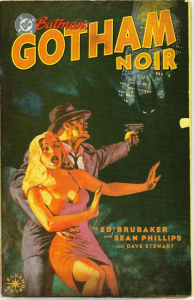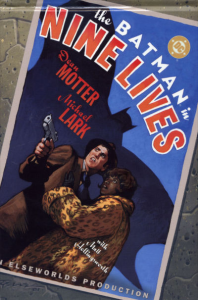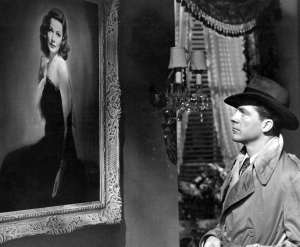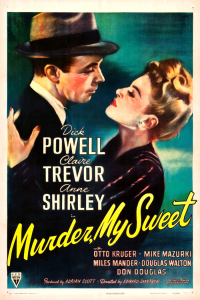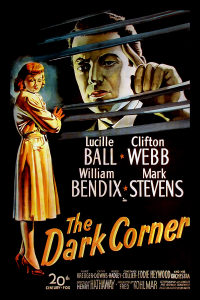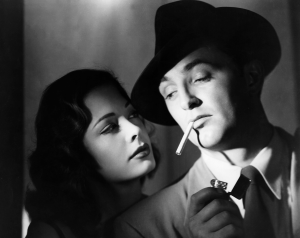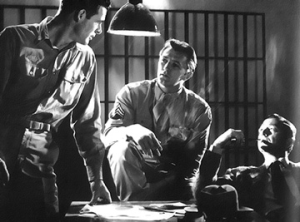Although film noir was a product of the 1940s and (arguably) the 1950s, since then its serpentine plots, mordant dialogue, and shadowy atmosphere have persistently inspired spoofs as well as straight-faced pastiches, including several Batman comics. With that in mind, last year I suggested that fans of the Dark Knight check out The Maltese Falcon. And this week I’m recommending another 15 detective films which are cut from the same cloth.
Let me start by pointing out that Batman’s whole noir connection makes a lot of sense, and not just because of his pulpy origins – after all, Batman is supposed to be the World’s Greatest Detective and the ‘tough detective’ has become one of the most recognizable noir tropes, popularized by private eyes like Sam Spade and Philip Marlowe (created by Dashiell Hammett and Raymond Chandler, respectively). And as much as Gotham has changed throughout the years, it is typically as full of sadistic mobsters and desperate suckers as the cities in those classic Hollywood crime movies.
A couple of comics have gone further than others, fully reimagining Batman’s cast through mysteries set in the film noir era:
Gotham Noir casts James Gordon as a heavy-drinking private investigator and Selina Kyle as a Rita Hayworth-looking nightclub owner, among other familiar names. Set in 1949, this is a sordid tale that pays homage to noir conventions such as the narrated flashback structure while tapping into the mood of post-WWII trauma and disenchantment. It’s an early collaboration by Ed Brubaker and Sean Phillips, two devout fans of the genre (they also paid homage to Hammett in their Hawkman story ‘The Black Bird’ and are currently working on the noir series The Fade Out).
Another Elseworlds comic, Nine Lives has shamus Dick Grayson look into the murder of an African-American Selina Kyle, with the nine suspects being clever combinations of Batman characters and noir clichés. Dean Motter’s tight script delivers the obligatory easter eggs, but it also has more than a few surprises up its sleeve. And if Phillips did a stellar job of channeling the aesthetics of period posters in Gotham Noir, here Michael Lark’s photorealistic art – with colors by Matt Hollingsworth – makes you feel like you’re actually watching a reel for the best-looking neo-noir movie this side of The Man Who Wasn’t There.
All in all, these are truly great comics which work as internally consistent thrillers while also providing Batman fans with amusing intertextual winks. Marvel successfully adopted the same formula years later, publishing cool noir versions of the X-Men, Spider-Man, and Luke Cage.
That said, there’s nothing quite like the original movies:
TIME TO KILL (1942)
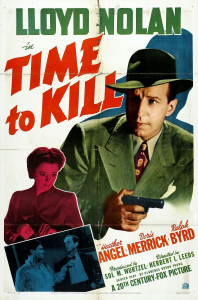 -And don’t leave town. We want a statement!
-And don’t leave town. We want a statement!
-You can have the one the bank sent me. You’ll get a great laugh out of that.
Let’s get this out of the way: I’m not including the overrated Philip Marlowe movie The Big Sleep on this list, because I honestly think you can have a much better time reading the original novel. However, I can’t resist recommending the much lesser known Time to Kill, which is also an adaptation of a Marlowe story (The High Window), even if the protagonist has been changed to private detective Michael Shayne (played with gusto by Lloyd Nolan). Without an ounce of pretension, this is a well-paced mystery spiced up with sharp one-liners.
LAURA (1944)
-I don’t use a pen. I write with a goose quill dipped in venom.
As the police detective investigating the murder of a beautiful advertising executive, Mark McPherson (Dana Andrews) is a terrible cop, letting a suspect tag along with him as he interrogates other suspects and unhealthily falling in love with the dead victim. To make matters worse, the case is anything but straightforward (there’s a shocking plot twist halfway through) and the people involved can be deliriously eccentric, especially newspaper columnist Waldo Lydecker (Clifton Webb) who spouts priceless lines like ‘In my case, self-absorption is completely justified. I have never discovered any other subject quite so worthy of my attention.’
Laura isn’t as hardboiled as the other entries on this post (or as the later collaboration between Andrews and director Otto Preminger, Where The Sidewalk Ends, also a twisted cop story). However, the film is justly celebrated as an alluring tale of dark obsession hiding underneath the veneer of upper class sophistication.
(By the way, Preminger totally played Mr. Freeze on a couple of episodes of the Batman TV series! And Vincent Price, who is one of the suspects here, played the egg-obsessed villain Egghead!)
MURDER, MY SWEET (1944)
-You’re not a detective, you’re a slot machine. You’d slit your own throat for 6 bits plus tax.
Another Philip Marlowe mystery, now starring Dick Powell, Murder, My Sweet – based on the novel Farewell, My Lovely – is the most stylish of the Chandler adaptations (although Lady in the Lake gets extra points because 95% of the movie is shot from Marlowe’s POV). The plot is convoluted to the point of madness, so it’s better to just enjoy each set piece as it comes and bask in all the noirishness.
While the unnecessarily romantic ending isn’t as powerful as the novel’s cynical last line, at least the film skips the racism that permeates the book while keeping plenty of Chandleresque wit.
THE KILLERS (1946)
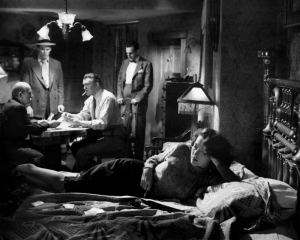 -Me and the Swede were about as close as two guys can get. For nearly two years we weren’t more than eight and a half feet apart. That’s how big the cell was.
-Me and the Swede were about as close as two guys can get. For nearly two years we weren’t more than eight and a half feet apart. That’s how big the cell was.
The first minutes of the quintessential noir The Killers are a badass adaptation of an Ernest Hemingway short story about a prizefighter (Burt Lancaster) who refuses to either resist or run away when a couple of hitmen come for him. From then on, we follow life insurance investigator Jim Reardon (Edmond O’Brien) as he tries to figure out why the boxer didn’t fight for his life. In the ensuing chain of flashbacks, it becomes increasingly clear that Ava Gardner’s femme fatale must have something to do with it.
Much like in his underrated noir Cry of the City, Robert Siodmak drenches The Killers in atmospheric chiaroscuro and directs each scene as if his life depends on it, delivering a hell of a crime drama.
THE DARK CORNER (1946)
-The enjoyment of art is the only remaining ecstasy that is neither immoral nor illegal.
The Dark Corner doesn’t provide much of a mystery, but it’s still a taut detective story, as private eye Bradford Galt (Mark Stevens) finds himself stalked, threatened, knocked out, and framed for murder. Once again, Clifton Webb gets the quirkiest lines (‘How I detest the dawn. The grass always looks like it’s been left out all night.’), but Stevens is the one who utters the gritty monologue that justifies the film’s title: ‘I feel all dead inside. I’m backed up in a dark corner and I don’t know who’s hitting me.’
OUT OF THE PAST (1947)
-She can’t be all bad. No one is.
-Well, she comes the closest.
Probably the most awesome film noir ever made, with Robert Mitchum as a private detective and Jane Greer as the woman for whom he throws everything away, with a plot that keeps on spinning and dialogue that feels like each character had 24 hours between sentences to think of the perfect comeback, with unforgettable expressionist lighting and more cigarette smoke than the last ten movies you’ve seen combined.
CROSSFIRE (1947)
-Is he dead?
-He’s been dead for a long time and didn’t even know it.
Besides Murder, My Sweet, director Edward Dmytryk was also behind this fascinating drama where a police captain (Robert Young) and a military sergeant (Robert Mitchum) investigate a murder involving a group of demobilized soldiers. More than the identity of the murderer, at the core of the film is the killer’s motivation – mixing police procedural and hate crime, Crossfire anticipates David Mamet’s Homicide, another gripping detective story about anti-Semitism.
What’s more, Crossfire sidesteps its B-movie origins by obscuring the settings with moody darkness and turning the absence of score into unsettling silences. The effect is chilling.

